Trying out twig tracking
At the Environmental Learning Center, the weather this week hints almost of spring. It is tempting to get swept away from the season at hand into those of the future. But winter is not a season to be wished away, it is a season to be savored.
With snow’s presence lacking on the surrounding landscape, I find myself looking for other, less obvious signs of winter’s presence. I want to dig deeper into the often remarked “dreary†landscape of winter to bring out, instead, the vibrant shades and shapes that exist as my knowledge of this place’s natural history grows. Through twig tracking – the identification of deciduous shrubs and trees based on bud placement, plant shape, and twig color and texture – I am able to expand my engagement, understanding, and appreciation for the wintry North Cascades.
You need not travel far from your home to decipher the first of many twig mysteries that, for other seasons, hide beneath layers of leaves, flowers and fruits. On a late afternoon walk to Diablo Dam, I identified over 10 species of deciduous trees and shrubs that flourished alongside the roadway. Who knows what additional wonders await when venturing further into the woods!
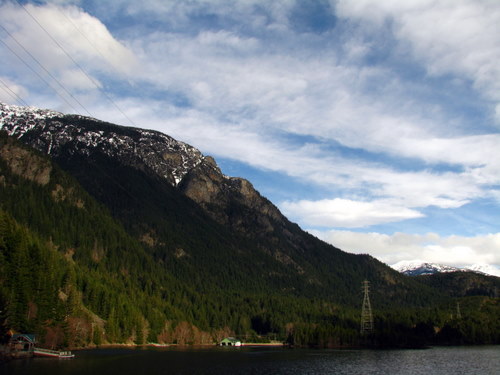 (Title) The pumpkin-like bud of a Pacific Dogwood found along Diablo Dam Road (Above) Winter’s blue skies reign over Sourdough Mountain and Diablo Lake
(Title) The pumpkin-like bud of a Pacific Dogwood found along Diablo Dam Road (Above) Winter’s blue skies reign over Sourdough Mountain and Diablo Lake
With assistance from Winter in the Woods – A Winter Guide to Deciduous Native Plants in Western Washington, a small publication from Washington State University’s Native Plant Salvage Project, I learned valuable terms any aspiring twig tracker should know. Allow me to indulge and name a few.
Alternate refers to the bud positioning on the stem, only one per node. Opposite means two buds per node on opposite sides of the stem. An appressed bud is one pressed closely to the twig itself. Lenticels are pores – raised or flat – that assist in gas exchange. Catkins are the male parts, containing pollen. The flowering part of the plant is known as inflorescence. And the fuzzy hairs found on twigs and buds, well, that is pubescence.
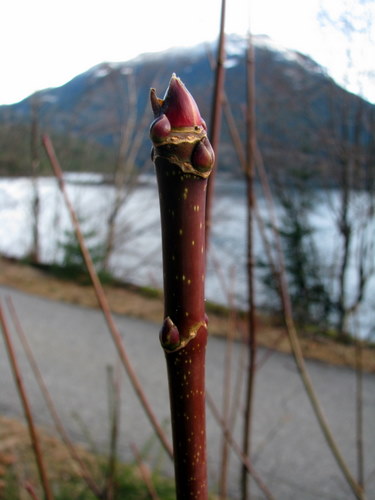 Bigleaf maple
Bigleaf maple
Bigleaf Maple – Acer macrophyllum– Features: Stem is large & stalky in shape, Smooth, shiny, deep red bark, Slightly raised pale lenticels, Buds rounded with opposite arrangement.
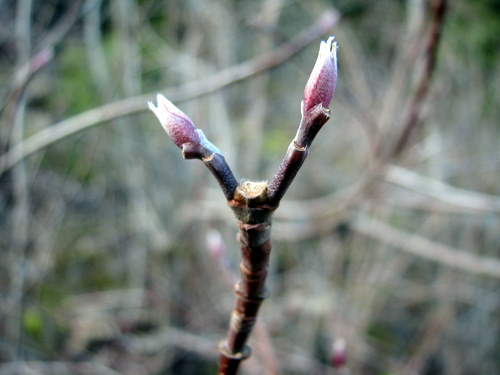 Pacific Dogwood
Pacific Dogwood
Pacific Dogwood – Cornus nuttallii – Features: Smooth, dull gray bark with pubescence, Slender, pointed buds in opposite arrangement, Bud scales red, purple or green, Pumpkin-like buds are fruiting parts.
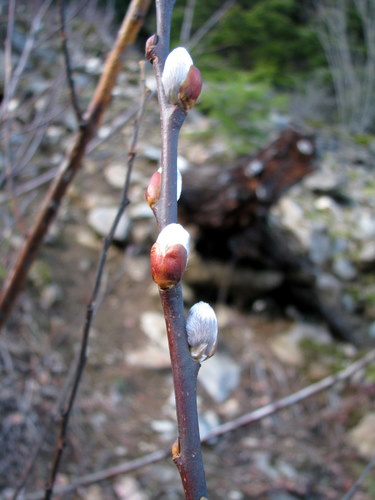 Many willow species occur in our region such as Pacific Willow & Sitka Willow
Many willow species occur in our region such as Pacific Willow & Sitka Willow
Willow – Salix (spp.) – Features: Lime green to golden bark, Pink to red appressed buds in alternate bud arrangement.
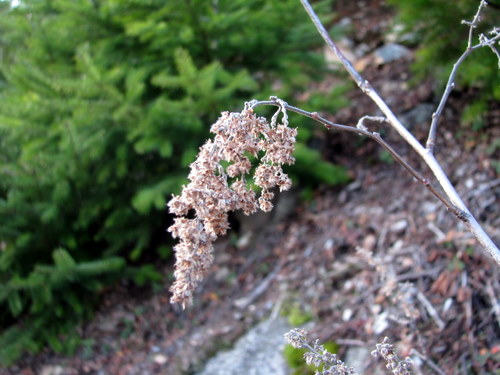 Oceanspray
Oceanspray
Ocean Spray – Holodiscus discolor – Features: Shredding gray to dull brown bark, Lenticels present but same color as twig, Pointed, tiny buds in alternate arrangement, Rich brown inflorescence can be found drooping in winter.
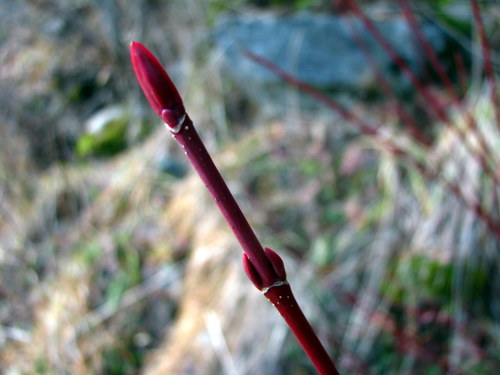 Red Oiser Dogwood
Red Oiser Dogwood
Red Oiser Dogwood – Cornus sericea – Features: Shiny, dark burgundy bark, Lenticels are prominent & raised, Elongated buds appressed to stem in opposite arrangement.
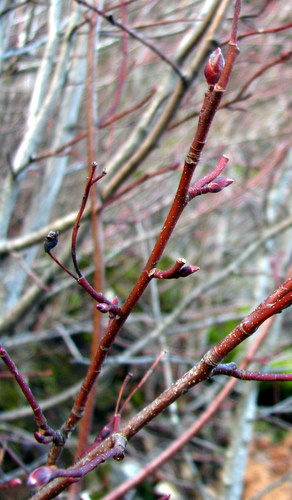 Indian Plum (Osoberry)
Indian Plum (Osoberry)
Indian Plum (Osoberry) – Oemleria cerasiformis – Features: Olive green to reddish bark, Lenticels are pink/tan & elongated up stem, Bright green buds in early winter and rosier in late winter in alternate arrangement.
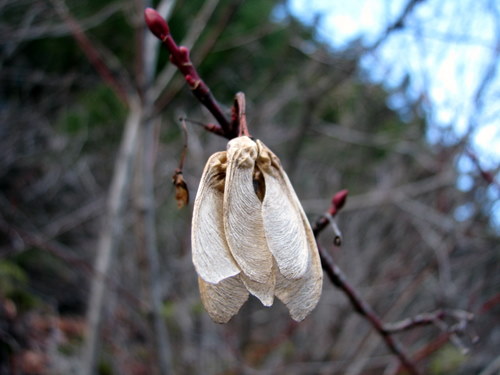 Douglas Maple
Douglas Maple
Douglas Maple – Acer glabrum – Features: Burgundy & brown, shiny bark, Slender Burgundy buds in opposite arrangement, Remnant inflorescence known as samara typical.
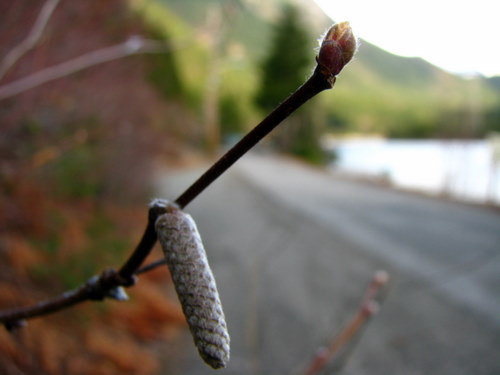 Western Hazelnut
Western Hazelnut
Western Hazelnut – Corylus cornuta – Features: Gray- to chesnut- brown bark covered in pubescence, Lenticels present but not raised, Light brown oval buds in alternate arrangement, Greenish tan, small catkins present in singulars or pairs.
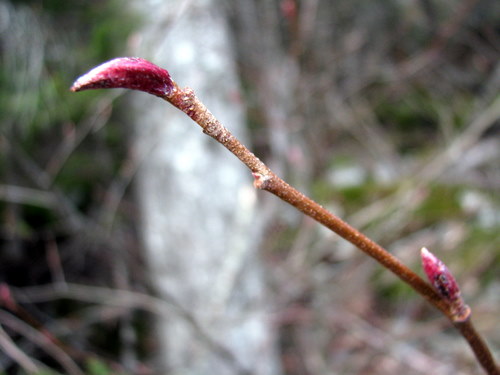 Red Alder
Red Alder
Red Alder – Alnus rubra – Features: Numerous lenticels on reddish-green bark, Alternate arrangement for slender & slightly curved red buds, Larger clusters of catkins remain in winter.
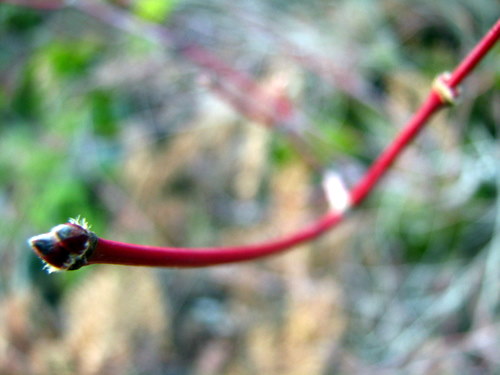 Vine Maple
Vine Maple
Vine Maple – Acer circinatum – Features: Shiny, red or pink bark, Small pale lenticels, Deep burgundy buds in opposite arrangement, Terminal buds appear in pairs like a deer hoof with hairs emerging from bud tips.
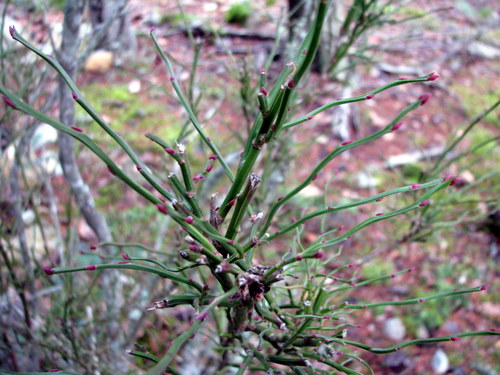 Red Huckleberry
Red Huckleberry
Red Huckleberry – Vaccinium parvifolium – Features: Lime green young bark, twigs have sharp ridges, Tiny pink buds are appressed & in alternate arrangement.
Painting a winter portrait of this place need not involve brush strokes of dull browns, grays and muted greens. By trying out twig tracking, I have begun to see the finer, more delicate details instead. A dab of pink bud here. A stem cloaked in deep red there. Twigs of all sizes twisting and turning upward. All of this wondrous winter activity, taking place under the brush stroke of a spring-like blue sky.


Great job – thanks for the lesson on this – I have always been curious about this and now I know more. Your research and photos really tell the story. Is this a class in the making?
I found this winter twig identification key from the Burke Museum at the UW that seems like it could be really helpful.
http://biology.burke.washington.edu/herbarium/imagecollection.php?Page=wintertwigkey.php